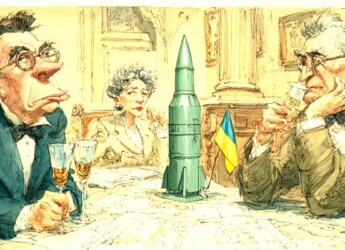|
|
Content Assessment: A Significant Operational Defeat? Ukraine Conflict Assessments in Maps (September 27 - October 1, 2022)
Information - 95%
Insight - 94%
Relevance - 94%
Objectivity - 96%
Authority - 97%
95%
Excellent
A short percentage-based assessment of the qualitative benefit of the post highlighting the recent Ukraine conflict assessments in maps from the Institute for the Study of War.
Editor’s Note: One of the most accurate and detailed sources for ongoing updates on the Ukraine crisis is the Ukraine Conflict Update from the Institute for the Study of War. The Institute for the Study of War (ISW) is a 501(c)(3) organization and produces strictly non-partisan, non-ideological, fact-based research. ISW seeks to promote an informed understanding of war and military affairs through comprehensive, independent, and accessible open-source research and analysis. ISW’s research is made available to the general public, military practitioners, policymakers, and media members. Providing a daily synthesis of key events related to the Russian aggression against Ukraine, ISW updates may benefit cybersecurity, information governance, and legal discovery professionals as they follow the business, information technology, and legal trends and trajectories impacted by and stemming from the current Ukraine conflict.
Assessment and Maps*
Ukraine Conflict Assessments – An Overview in Maps
- Institute for the Study of War (ISW), Russia Team
- Critical Threats Project (CTP), American Enterprise Institute
General Assessment Background Info
- ISW systematically publishes Russian campaign assessments that include maps highlighting the assessed control of terrain in Ukraine and main Russian maneuver axes.
- These maps augment daily synthetic products that cover key events related to renewed Russian aggression against Ukraine.
The Russian Offensive Campaign Assessments
- October 1, 2022
- By Kateryna Stepanenko, Katherine Lawlor, George Barros, Riley Bailey, and Frederick W. Kagan
Key Development
- Ukrainian forces inflicted another significant operational defeat on Russia and liberated Lyman, Donetsk Oblast, on October 1. The Russian Ministry of Defense (MoD) announced the withdrawal of Russian troops from Lyman to “more advantageous positions” to avoid the “threat of encirclement” in the settlement. Social media footage and Ukrainian military officials confirmed that Ukrainian forces have entered Lyman and are likely clearing the settlement as of October 1.
Key Takeaways
- Ukrainian forces liberated Lyman and are likely clearing the settlement as of October 1.
- Russia is likely setting conditions to assume legal responsibility for the Zaporizhzhia Nuclear Power Plant (ZNPP).
- Ukrainian troops are continuing to conduct counteroffensive operations in Kherson Oblast and setting conditions for future advances.
- Russian forces conducted ground attacks in the Bakhmut and Avdiivka areas of Donetsk Oblast.
- Russian forces continued routine strikes against Ukrainian rear areas in the south.
- Russian military leadership is continuing to compromise the future reconstitution of the force by prioritizing the immediate mobilization of as many bodies as possible for ongoing fighting in Ukraine.
- Russian mobilization authorities continue to carry out discriminatory mobilization practices.
- September 30, 2022
- By Kateryna Stepanenko, Katherine Lawlor, Grace Mappes, Riley Bailey, George Barros, and Frederick W. Kagan
Key Development
- Russian President Vladimir Putin did not threaten an immediate nuclear attack to halt the Ukrainian counteroffensives into Russian-occupied Ukraine during his speech announcing Russia’s illegal annexation of Ukrainian territory.
Key Takeaways
- Russian President Vladimir Putin announced the illegal Russian annexation of four Ukrainian territories on September 30 without clearly defining the borders of those claimed territories.
- Putin announced that Russia’s usual autumn conscription cycle will start a month late on November 1, likely because Russia’s partial mobilization of Russian men is taxing the bureaucracy of the Russian military commissariats that would usually oversee the semi-annual conscription cycle.
- Russian officials could re-mobilize last year’s conscripts when their terms expire on October 1.
- Ukrainian forces will likely capture or encircle Lyman within the next 72 hours.
- Ukrainian military officials maintained operational silence regarding Ukrainian ground maneuvers in Kherson Oblast but stated that Ukrainian forces continued to force Russian troops into defending their positions.
- Russian troops continued ground assaults in Donetsk Oblast.
- Russian authorities continued efforts to coerce Russian participation in mobilization efforts, but will likely struggle to coerce participation as Russians continue to flee Russia for border states who welcome them.
- Russian officials are accepting bribes and engaging in other preferential treatment to prevent or ease the economic burden of mobilization on the wealthy.
- Russian authorities are continuing to deploy mobilized personnel to Ukraine without adequate training or equipment, and personnel are unlikely to be able to afford to provide their own supplies.
- Russian forces conducted a missile strike on a Ukrainian humanitarian convoy and attempted to blame the Ukrainian government.
- September 29, 2022
- By Kateryna Stepanenko, Karolina Hird, George Barros, Riley Bailey, and Frederick W. Kagan
Key Development
- The Kremlin continues to violate its stated “partial mobilization” procedures and contradict its own messaging even while recognizing the systematic failures within the Russian bureaucracy just eight days after the declaration of mobilization.
Key Takeaways
- The Kremlin continues to violate its stated “partial mobilization” procedures and contradict its own messaging even while recognizing the systematic failures within the Russian bureaucracy just eight days after the declaration of mobilization.
- Belarus may be preparing to accommodate newly-mobilized Russian servicemen but remains unlikely to enter the war in Ukraine on Russia’s behalf.
- Ukrainian troops have likely nearly completed the encirclement of the Russian grouping in Lyman and cut critical ground lines of communication (GLOCS) that support Russian troops in the Drobysheve-Lyman area.
- Ukrainian military officials maintained operational silence regarding Ukrainian ground maneuvers in Kherson Oblast but stated that Russian forces are deploying newly-mobilized troops to reinforce the Kherson Oblast frontline.
- Ukrainian troops continued to target Russian logistics, transportation, and military assets in Kherson Oblast.
- Russian troops continued ground attacks in Donetsk Oblast.
- Russian forces have likely increased the use of Iranian-made Shahed-136 drones in southern Ukraine.
- An independent Russian polling organization, the Levada Center, found that almost half of polled Russians are anxious about mobilization, but that support for Russian military actions declined only slightly to 44%.
- Ukrainian officials reiterated their concerns that the Kremlin will mobilize Ukrainian citizens in occupied oblasts following Russian President Vladimir Putin’s annexation announcement.
- September 28, 2022
- By Karolina Hird, Katherine Lawlor, Grace Mappes, Riley Bailey, and Frederick W. Kagan
Key Development
- Russian milbloggers discussed Ukrainian gains around Lyman with increased concern on September 28, suggesting that Russian forces in this area may face imminent defeat.
Key Takeaways
- Russian military leadership has likely failed to set information conditions for the potential defeat of the Russian grouping in Lyman, despite increasingly concerned discourse among Russian milbloggers regarding the potential for a Ukrainian envelopment of Lyman.
- The Kremlin could temporarily postpone announcing the annexation of Russian-occupied Ukrainian territory to better prepare the Russian information space and administrative organization, although September 30 remains the most likely date for some kind of annexation announcement.
- Russian authorities continue to send newly-mobilized and undertrained recruits to directly reinforce severely degraded remnants of various units, including units that were previously considered to be Russia’s premier conventional fighting forces.
- Ukrainian forces likely continued to make significant gains around Lyman on September 28, advancing from the north along the Zelena Dolyna-Kolodiazi arc and from the southeast around Yampil.
- Ukrainian military officials largely maintained operational silence regarding specific Ukrainian actions in Kherson Oblast on September 28 but stated that Ukrainian troops are continuing positional battles in unspecified locations to consolidate and improve their positions along the Southern Axis.
- Russian forces continued unsuccessful ground attacks in Donetsk Oblast.
- Russian military recruitment officials are openly contradicting the Kremlin’s publicly-stated guidelines for mobilization to meet quota requirements even as Kremlin propaganda is attempting to change the public perception of partial mobilization.
- Russian authorities are beginning to restrict movement of Russian citizens into Russian border regions to cope with hundreds of thousands of Russian men attempting to flee the country.
- September 27, 2022
- By Kateryna Stepanenko, Katherine Lawlor, Grace Mappes, Riley Bailey, and Mason Clark
Key Development
- Russian authorities in occupied parts of Ukraine’s Kherson, Zaporizhia, Donetsk, and Luhansk oblasts completed their falsified annexation “referenda” on September 27 and implausibly claimed that each sham referendum received between 87 and 99% approval from Ukrainian residents.
Key Takeaways
- Russian President Vladimir Putin will likely announce the Russian annexation of occupied Ukrainian territory on September 30 after Russian officials completed their falsified “referenda” on September 27.
- Russian forces are reportedly committing newly-mobilized Western Military District (WMD) men to the Kherson and Kharkiv Oblast frontlines without prior training.
- Ukrainian forces are consolidating their positions on the eastern bank of the Oskil river and made further gains on the outskirts of Lyman.
- Ukrainian forces continued to target Russian ground lines of communication (GLOCs) as part of the southern counter-offensive interdiction campaign, particularly disrupting Russian efforts to build barge crossings.
- Russian forces continued unsuccessful offensive operations around Bakhmut and west of Donetsk City, increasingly leveraging penal units.
- Russian forces inflicted severe damage on a Ukrainian airfield in Kryvyi Rih and continued routine air and missile strikes across southern Ukraine.
- Russian authorities are establishing checkpoints at Russia’s borders to forcibly mobilize Russian men who are seeking to avoid forced mobilization by fleeing the country.
- Russian officials are setting conditions to forcibly mobilize or conscript Ukrainian civilians in soon-to-be annexed areas of occupied Ukraine.
- The Russian annexation of occupied Donetsk and Luhansk will likely exacerbate tensions within DNR and LNR forces, who regularly mutiny when asked to fight outside the borders of their own oblasts.
- Russian officials may attempt to reframe their invasion of Ukraine and occupation of soon-to-be-annexed Ukrainian territory as a “counterterrorism operation.”
We do not report in detail on Russian war crimes because those activities are well-covered in Western media and do not directly affect the military operations we are assessing and forecasting. We will continue to evaluate and report on the effects of these criminal activities on the Ukrainian military and population and specifically on combat in Ukrainian urban areas. We utterly condemn these Russian violations of the laws of armed conflict, Geneva Conventions, and humanity even though we do not describe them in these reports.
Chronology of Maps from September 27 – October 1, 2022 – Mouseover to Scroll
Ukraine Conflict Maps - 092722-100122See the Institute for the Study of War Interactive Map of the Russian Invasion
Read the latest Ukraine Conflict updates from the Institute for the Study of War
* Shared with direct express permission from the Institute for the Study of War (ISW).
About the Institute for the Study of War Research Methodology
ISW’s research methodology relies on both primary and secondary sources, enabling researchers to develop a comprehensive understanding of the situation on the ground. In order to analyze military and political developments in any given area, ISW’s research analysts must wholly understand the systems of enemy and friendly forces. They must also understand the population demographics, physical terrain, politics, and history of that area. This lays the analytical foundation for understanding the reasons for particular developments and fulfilling their assigned research objectives. ISW analysts also spend time in places like Iraq, Afghanistan, and elsewhere in order to gain a better understanding of the security and political situation and to evaluate the implementation of current strategies and policies. Our researchers compile data and analyze trends, producing a granular analysis of developments in areas of research, producing an accurate, high-resolution, timely, and thorough picture of the situation. ISW’s research methodology guarantees its success and commitment to improving the nation’s ability to execute military operations, achieve strategic objectives, and respond to emerging problems that may require the use of American military power.
About the Institute for the Study of War
The Institute for the Study of War advances an informed understanding of military affairs through reliable research, trusted analysis, and innovative education. We are committed to improving the nation’s ability to execute military operations and respond to emerging threats in order to achieve U.S. strategic objectives. ISW is a non-partisan, non-profit, public policy research organization.
Learn more, get involved, and contribute today.
Additional Reading
- [Annual Update] International Cyber Law in Practice: Interactive Toolkit
- Data Embassies: Sovereignty, Security, and Continuity for Nation-States
Source: ComplexDiscovery


























